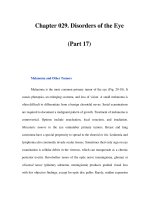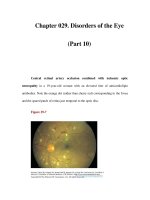Chapter 091. Benign and Malignant Diseases of the Prostate (Part 7) potx
Bạn đang xem bản rút gọn của tài liệu. Xem và tải ngay bản đầy đủ của tài liệu tại đây (13.67 KB, 5 trang )
Chapter 091. Benign and Malignant
Diseases of the Prostate
(Part 7)
Brachytherapy
Brachytherapy is the direct implantation of radioactive sources into the
prostate. It is based on the principle that the deposition of radiation energy in
tissues decreases as a function of the square of the distance from the source (Chap.
81). The goal is to deliver intensive irradiation to the prostate, minimizing the
exposure of the surrounding tissues. The current standard technique achieves a
more homogeneous dose distribution by placing seeds according to a customized
template based on CT and ultrasonographic assessment of the tumor and
computer-optimized dosimetry. The implantation is performed transperineally,
without an open procedure, with real-time imaging.
The improvements in brachytherapy techniques have resulted in fewer
complications and a marked reduction in local failure rates. In a series of 197
patients followed for a median of 3 years, 5-year actuarial PSA relapse–free
survival for patients with pretherapy PSA levels of 0–4, 4–10, and >10 ng/mL
were 98, 90, and 89%, respectively. In a separate report of 201 patients who
underwent posttreatment biopsies, 80% were negative, 17% were indeterminate,
and 3% were positive. The results did not change with longer follow-up.
Nevertheless, many physicians feel that implantation is best reserved for patients
with good or intermediate prognostic features.
Brachytherapy is well tolerated, although most patients experience urinary
frequency and urgency that can persist for several months. Incontinence has been
seen in 2–4% of cases. Higher complication rates are observed in patients who
have undergone a prior TURP or who have obstructive symptoms at baseline.
Proctitis has been reported in <2% of patients.
Active Surveillance
Active surveillance, described previously as watchful waiting, or deferred
therapy, is a policy of monitoring the illness at fixed intervals with DREs, PSA
measurements, and repeat biopsies of the prostate as indicated, but with no
therapeutic intervention(s) until the tumor progresses. Progression can be based on
PSA changes, local tumor growth, the development of symptoms, or metastatic
disease. The practice evolved from studies of predominantly elderly men with
well-differentiated tumors who demonstrated no clinically significant progression
for protracted periods, during which a significant proportion died of intercurrent
disease. In a structured literature review of patients treated by radical surgery,
external beam radiation, or a deferred approach, the 10-year survival rates were
93% for radical prostatectomy, 74% for external beam radiation, and 84% for
deferred treatment. Arguing against active surveillance are the results of a Swedish
randomized trial of radical prostatectomy vs. active surveillance. With a median
follow-up of 6.2 years, men treated by radical surgery had a lower risk of prostate
cancer death relative to active surveillance patients (4.6% vs. 8.9%) and a lower
risk of metastatic progression (hazard ratio 0.63).
Case selection is critical, and the criteria to select men who can safely
choose active surveillance are under intense study. In a prostatectomy series, it
was estimated that 10–15% of patients had "insignificant" cancers. Given the
multifocality of the disease, a concern is the limited ability to predict pathologic
findings on the basis of a needle biopsy, even when multiple cores are obtained.
Nomograms to help predict which patients can safely be managed by active
surveillance have been developed, and as their predictive accuracy improves, it
can be anticipated that more patients will be candidates.
Rising PSA
This state consists of patients in whom the sole manifestation of disease is a
rising PSA after surgery and/or radiation therapy. By definition, patients have no
evidence of disease on scan. For these patients the central issue is whether the rise
in PSA results from persistent disease in the primary site, systemic disease, or
both. In theory, disease in the primary site may still be curable by additional local
treatment; external beam radiation for patients who had undergone surgery,
prostatectomy for patients who had undergone radiation therapy.
The decision to recommend radiation therapy after prostatectomy is often
made on the basis of the pathologic findings at surgery, as imaging studies such as
CT and bone scan are typically uninformative. Some recommend a Prostascint
scan: imaging with a radiolabeled antibody to prostate-specific membrane antigen
(PSMA), which is highly expressed on prostate epithelial cells, to help with this
distinction. Antibody localization to the prostatic fossa suggests local recurrence;
localization to extrapelvic sites predicts failure of radiation therapy. Others
recommend that a biopsy of the urethrovesical anastomosis be obtained before
considering radiation. Factors that predict for response to salvage radiation therapy
are a positive surgical margin, lower Gleason grade, long interval from surgery to
PSA failure, slow PSA doubling time, and low (<0.5–1.0 ng/mL) PSA value at the
time of radiation treatment. Radiation therapy is generally not recommended if the
PSA was persistently elevated after surgery, which usually indicates that the
disease had spread outside of the area of the prostate bed and is unlikely to be
controlled with radiation therapy.









